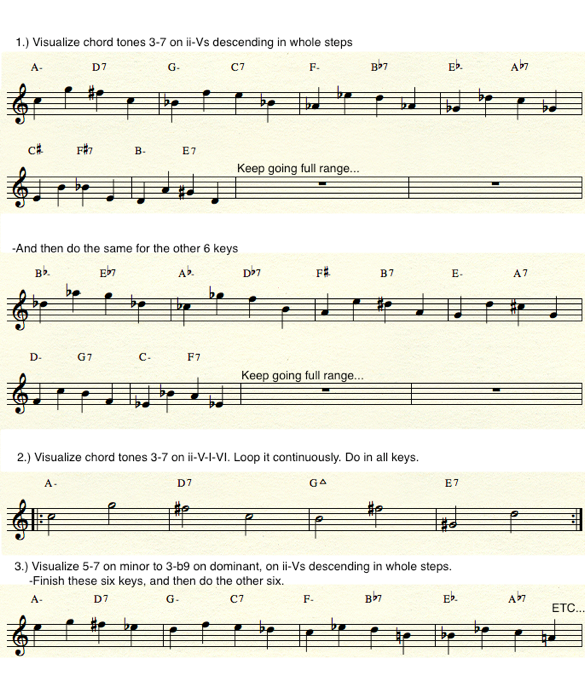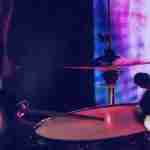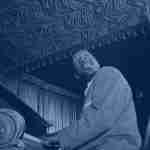Countless hours in the practice room and rhythm changes or a simple bridge to a tune still giving you a tough time? This is a familiar situation to everyone of all levels. I used to waste hours mindlessly practicing, thinking that there was some secret I was missing, or if I just kept improvising over the changes, I would eventually just get it. Or maybe it wasn’t the changes at all, but maybe it was something faulty with my equipment. Oh yes, that had to be it. If I could just get my hands on the right mouthpiece or that latest ligature then…that had to be it!!!
This attitude is completely delusional, yet many of us continue to think this way for years! Playing over a tune constantly, hoping that eventually you’ll play well over it is a mindless pursuit, as is blaming your equipment for your shortcomings as an improviser.
In actuality, the problem is not external. We hold in our mind what we will play before we even pick up our horn, therefore, to change what we are going to play, we have to change what’s stored in our mind. Sure, when you practice your instrument, your mind is altering its stored information, but what if you could simply go directly to your mind and start fixing the bugs? That is where visualization comes into the picture.
Defining Visualization
The dictionary defines visualization as the formation of mental images. For the purposes of this article, think of it as creating a mental image of chord tones and progressions in the mind’s eye, accompanied by a tactile and aural sense. Don’t worry if you don’t completely understand yet. It will become extremely clear as we progress.
Mental Roadblocks
Ok. So you’re soloing over a familiar tune and everything is going great. You’re feeling good and then all of sudden, you hesitate for a moment. You think to yourself, “What chord am I on?” By the time you figure it out, the chord is long gone. When your mind stumbles on a roadblock like that, your flow is broken and all sense of creativity is lost.
These roadblocks that exist in our minds are made up of lapses in time. They could be the time that it takes to know the chord you’re on, the right notes to play, where you are in a tune etc. They could be seconds long or they could be milliseconds. The point is that if they are there, that is bad.
Practicing visualization reduces the time it takes to recall elements of the tune, until they are ingrained in your mind. In time, these mental roadblocks will disappear. Then, when you do go to the practice room or the bandstand, you’ll be armed with the confidence to have a more productive, positive, and fun experience.
Removing Roadblocks
Gradually, one by one these roadblocks can be removed, until all that is left is a super highway of your own creativity. How do you do this? Start with the exercises below and practice them diligently everyday. They really don’t take much of a time commitment and the rewards are huge. I’ve written out an entire series of exercises that I put on my night stand and for fifteen minutes before I go to bed, I simply run through them. Once you get proficient in visualization, you’ll be able to do it anywhere and take advantage of the many segments throughout the day that you have a few minutes to kill.
Why Visualization is so Effective
When you are visualizing, your mind doesn’t know that your body is not actually engaging in the real activity. By working directly with your mind, as opposed to your body and then your mind, you are going straight to the source. Check out what Jerry Bergonzi says in his wonderful book which I highly recommend for anyone at any level, Melodic Structures:
“With the use of visualization, the mind actually teaches the body and the mind remembers what the body is more apt to forget. The mind visualizes what the body does in multi-dimensional fashion. It practices the fingerings and the notes, it hears the sound and the content, it feels the intention, the emotion, and the nuances of what is played. The body then follows suit. The body teaching the mind is actually a backward process and for this reason through the use of visualization we are able to learn more quickly. Wherever you have a difficult time mentally is where you will encounter problems playing on your instrument. Work it out mentally and you will no longer have these problems. With practice, whatever you are able to visualize you will then be able to play” (Bergonzi, 32).
Not convinced yet? Well you should be, but if that’s not enough, Bergonzi adds that “Very often ten minutes of visualization is equivalent to two hours of physical practice” (Bergonzi 32). With a return on your time like that, why wouldn’t you want to spend as much time doing this as possible?!
Getting Started with Visualization
It may take a few days to get comfortable visualizing, but after the initial phase, it will be easy. Start out with this simple exercise:
- Sit somewhere comfortable where you will not be disturbed. Later you will be able to do this anywhere, but right now use all the help you can get.
- In your mind’s eye, see the chord symbol for C Major (I try to keep things as simple as possible, so even for C major seven, I would just visualize the image below)
- Congratulations you just visualized! Easy right? Ok enough, celebration we’ve only just begun. Now see a music staff below the chord symbol
- Once you can clearly visualize the chord symbol with the staff, add the root of the chord to the picture.
- Now you are going to add an aural sense to the equation. Hear how you think that root sounds on that C Major chord. Often I hear piano and I try to hear a solid pitch. Don’t worry about the absolute pitch. I do not have perfect pitch, however, through these exercises, coupled with daily ear training, you will develop the necessary relative pitch to hear chord motion while visualizing. As you get more advanced, you will want to learn how to hear the chord in the background of the pitch you are focusing on as well.
- Next add a tactile sense. Feel exactly how it would feel to play that note on your instrument. If you play saxophone like me, at this point you will be seeing the image of the C Major chord symbol above a staff with the note ‘C’ on it, while you are hearing the note ring in your head, and feeling how it would be like to push the key down with your left middle finger.
So that is basic visualization. Here are some variations to try before moving on:
- See, hear, and feel (all at the same time) different chord tones on the C Major chord. For example, after you have done the root, try the third, and then the fifth and so on, until you have visualized all the chord tones.
- Try visualizing pairs of notes. A valuable pair as you would have guessed is three-seven. You could see them as a block chord or try seeing a half-note of the third and a half-note of the seventh.
- Experiment with groups of three, four, or even five notes. The possibilities are endless. Be creative!
Practice these steps until it is second nature to be able to see, hear, and feel chords and chord tones in your head simultaneously. When you feel confident, begin to apply these steps to some progressions.
Applying Visualization to Common Chord Progressions
Since the ii-V-I is so common, it is always a good place to start. In this exercise, we are going to visualize a ii-V-I in C major. Follow these steps to get a handle on visualizing through progressions:
- Again, sit somewhere where you won’t be bothered to avoid distractions while you are first starting out.
- First, see the chord symbols in your mind’s eye.
- Next add the staff
- Now add the roots of the chords to the picture
- Add the sound of each note and this time try to hear the chord in the background as well. Keep the note on the staff the prominent sound though.
- Feel the notes under your fingers as you progress from one chord to the next in time. (Yes, eventually you want to keep a consistent tempo through the progression)
- Now visualize half notes of the third and seventh of each chord, progressing in time from one chord to the next. Pay special attention to the transitions as the seventh of one chord goes to the third of the next.
- Loop step 7 until you can instantaneously ‘feel’ the chord tones, even before you arrive to them in the exercise. For instance, you are thinking of D-, yet you feel, see, and hear G7 before you even get there.
Visualizing the third and seventh as in step #7 is essential to hearing a progression operate in your mind’s ear. After practicing these resolutions, your ear will guide you through the changes much more smoothly. Your dependency on background tracks or comping instruments will diminish and you will feel much more confident.
Visualization Drills Based on Common Chord progressions
Here are some drills based on frequently encountered chord progressions. They are selected from the exercises that I run through each night and they continue to help me tremendously.
Endless Possibilities of Visualization
This is just a starting point. After working on these exercises for a while, start to create your own. Try experimenting with:
- Different chord tone combos
- Altered chord tones, b9, #9, b5, b13 etc.
- Other chord progressions that you encounter frequently
- Any progression that gives you a tough time
- Blues changes
- Rhythm changes
- Standards you are working on
Jazz visualization is so important and effective, that we actually have crafted a Jazzadvice Course on Jazz Visualization to help you master all the necessary pieces of it!
So if you want to take your jazz chord, tune, and progression skills to the nest level, make sure to checkout the course…
The possibilities of applying visualization to help you become a better improviser are literally endless. Have fun trying it out and stay tuned for plenty more about visualization in the future!


















